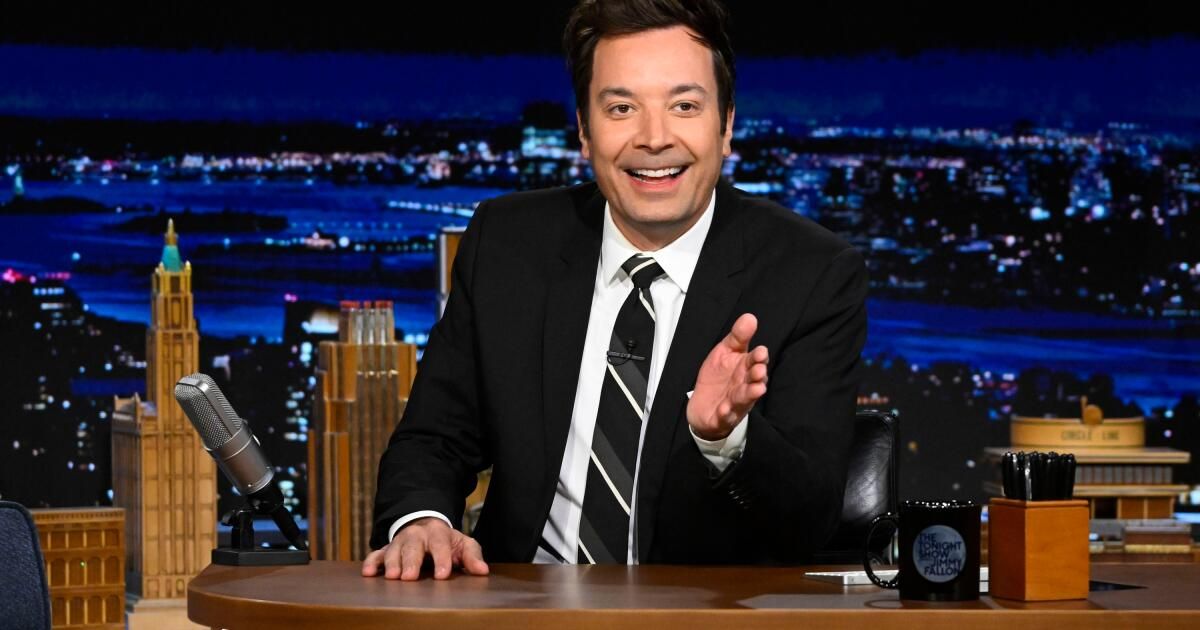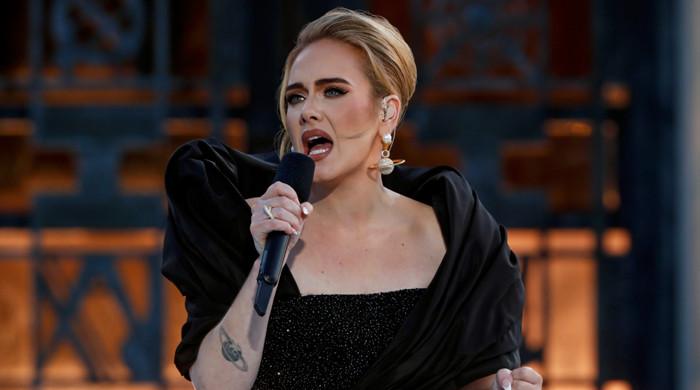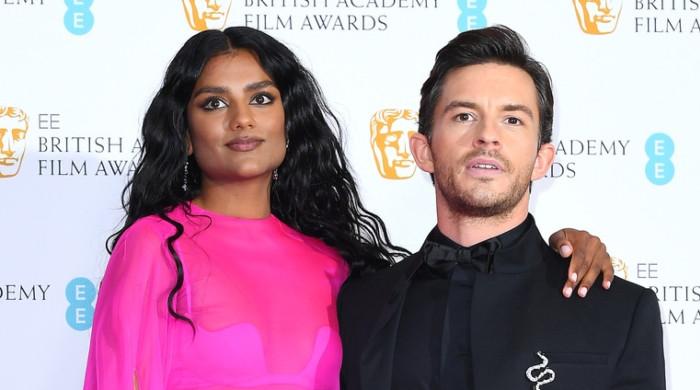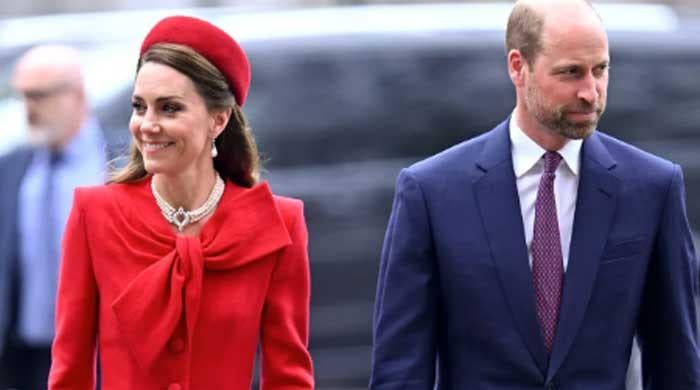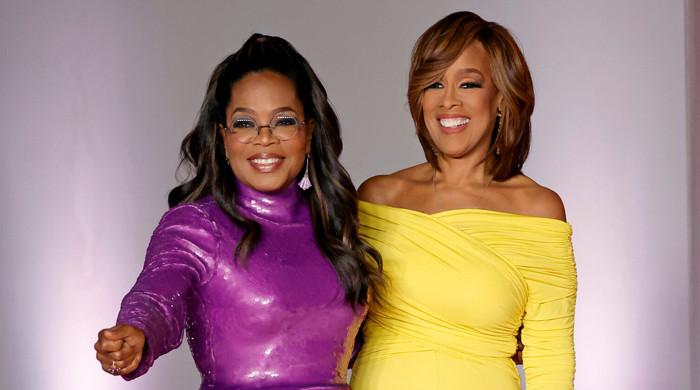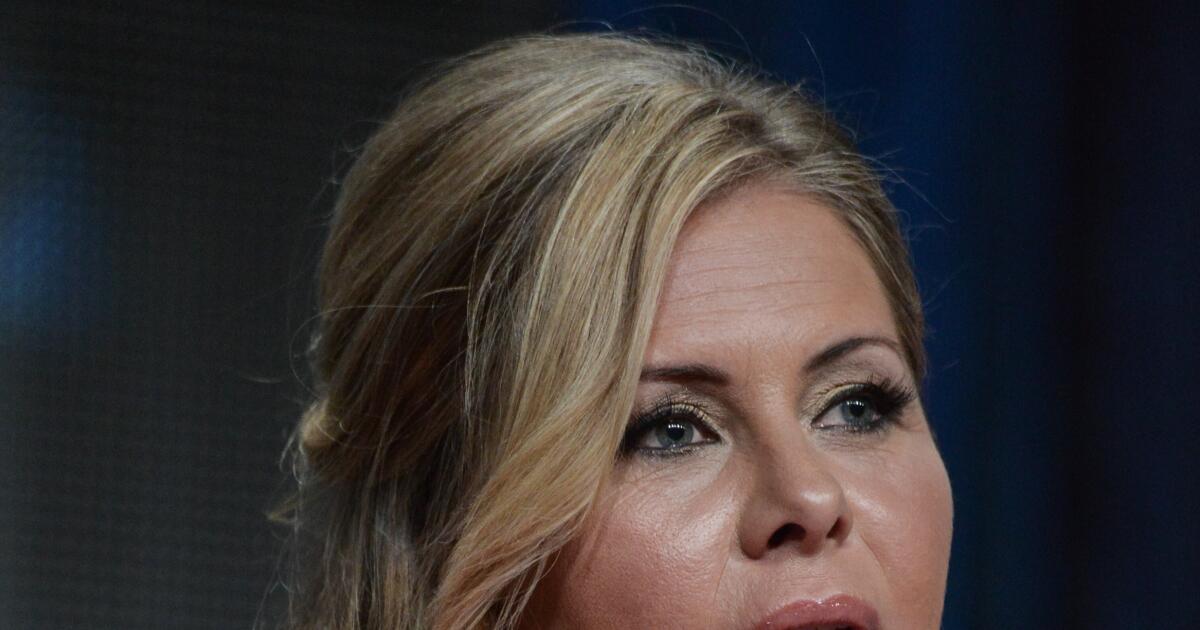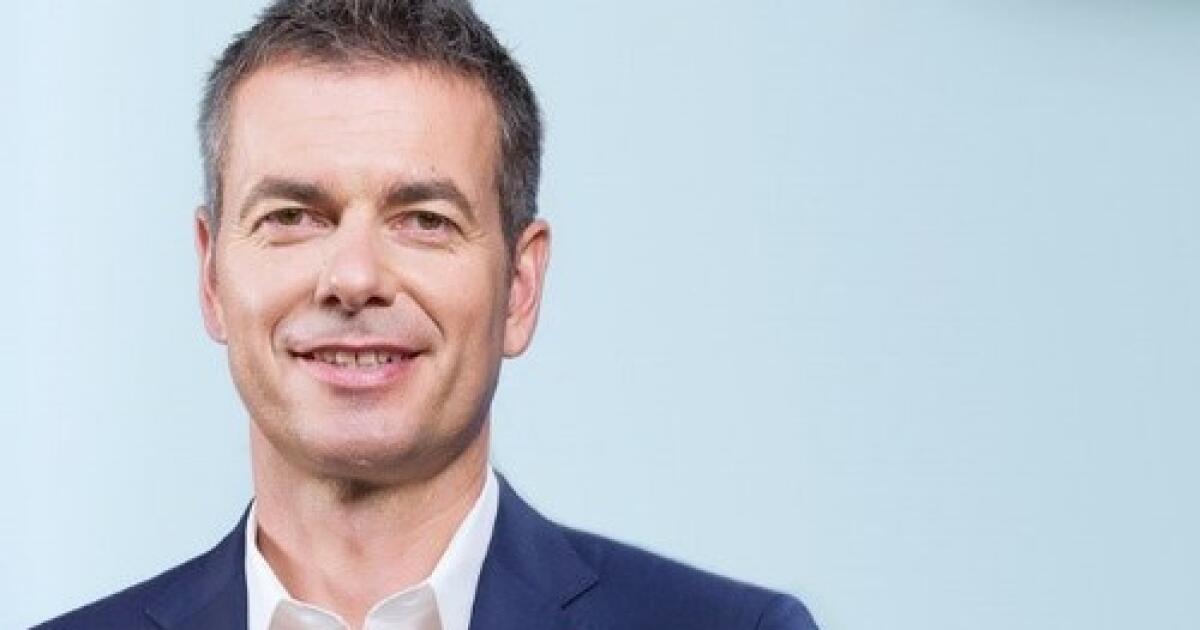On Tuesday night, NBC will air a two-hour special celebrating Jimmy Fallon's 10 years as host of “The Tonight Show.” It's a clip show, meaning for younger viewers, it's like YouTube, but on television, but they can't choose the videos.
Strictly speaking, despite the time slot and the name, it's a 15th anniversary for Fallon, who was doing substantially the same show for five years at 12:35 a.m., as “Late Night with Jimmy Fallon,” the slot that now occupies Seth Meyers. and previously by Conan O'Brien. However, when it comes to “The Tonight Show,” the name and time matter; So historic and prestigious is this area of post-prime time real estate that real wars have been fought over its reach. Friendships ended. Books were written. One was made into an HBO television movie. The people took sides. Team Dave. Team Jay. I'm with Coco. Do you remember.
Conan O'Brien, left, during an interview with Jay Leno in 1995. O'Brien's tenure as host of the “Tonight Show” was short-lived after a dispute over scheduling.
(Margaret Norton/NBCU Photo Bank/NBCUniversal via Getty Images)
The brand itself is celebrating its own anniversary this year. Almost seven decades have passed since it premiered, in September 1954, as “Tonight” with Steve Allen as host, when all television was exclusively what is now called “linear,” in the sense that you could go from the point A to point B with a single network, from the time of your promotion to the time of your retirement. (An even more likely possibility before the introduction of the remote control.) With its morning shows, its afternoon soap operas and game shows, its prime time, its late-night and, eventually, late-night programming, broadcast television reflected and shaped the day, waking you up, tucking you in. And it was tacitly understood that an audience that chose to stay up after the local news, after midnight on weekdays, might be ready for something relatively sophisticated, cosmopolitan and a little daring.
“The Tonight Show,” of course, will mean something different depending on when you boarded that train, just as your “Saturday Night Live” (about 50) won't necessarily be mine. Allen and Jack Paar, who followed him, built the architecture and the audience, but most of all, the program and shape of late-night television was defined over 30 years by its third host, Johnny Carson, a figure of Tal cultural importance that Beach Boy Brian Wilson wrote a song about him. (“Don't you think he's such a natural guy? / The way he's kept it going could make you cry.”)
From 1962 to 1992, Carson owned it late into the night as competition came and went. It wasn't until David Letterman opened its doors with “Late Show” on CBS, after NBC named Jay Leno to succeed Carson, that “The Tonight Show” had a long-running competitor, one that, under Letterman, also It became an institution. .
Many viewers will undoubtedly have no contemporary memories of Carson, although clips of the show are all over YouTube and a selection of episodes air on Peacock as “The Johnny Carson Show.” (Unfortunately, most of Carson's shows from the 1960s have been deleted.) Free and friendly, the host sincere, curious, kind and good-humored, was a Hollywood party, especially in the years when it stretched to a leisurely 90 minutes, with room to stretch out and guests gathering on the couch.
Carson's “Tonight Show” wasn't exactly the promotional mill that talk shows have become, but rather a clubhouse, like at Friars, that drew guests in again and again, not because they had anything to sell. (although comedians are always about to appear somewhere). but because they were entertaining, because Carson liked them or, in any case, liked the energy they brought to the show. It was a space that could turn an aspiring comedian into a success overnight, if he received the host's blessing: a gesture to sit down.
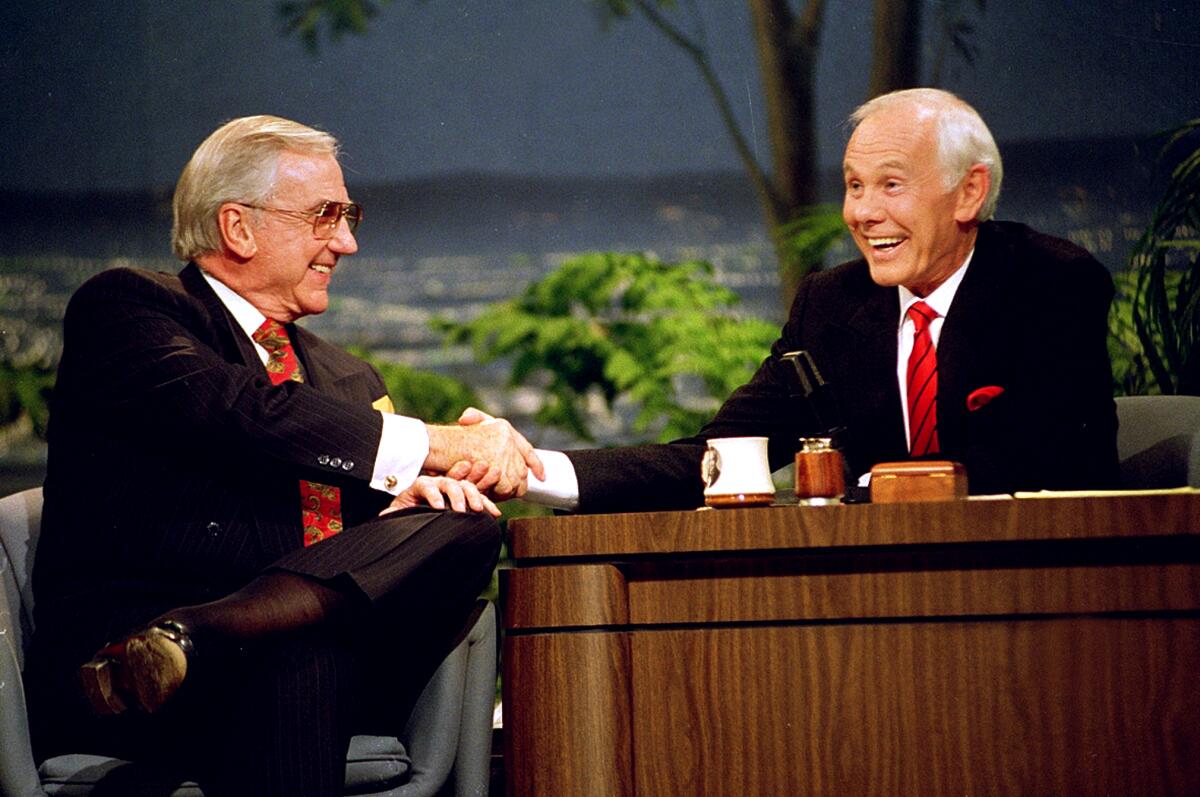
Ed McMahon, left, with Johnny Carson, during the final taping of Carson's “Tonight Show” in Burbank.
(Douglas C. Pizac/Associated Press)
This family feeling extended to the guest hosts (Carson's regular absences and shortened workweek were legendary), most of whom were guests before they were hosts, and some of whom got their own talk shows afterward. Among them were Robert Klein, Jerry Lewis, Flip Wilson, George Carlin, Woody Allen, Sammy Davis Jr., Groucho Marx and David Brenner. Joan Rivers, one of the few women among them, earned Carson's enmity by accepting a deal with Fox to host her own competitive talk show; Garry Shandling, whose big break came from an appearance on the “Tonight Show,” poured the experience into “The Larry Sanders Show.”
Carson had been Letterman's leading man for 11 years; the two were mutual admirers and close professionally. Their styles were wildly different, but his energy and intelligence were similar, and it came as a shock to many when NBC gave Leno the spot. (“How angry are you?” Carson asked a guest Letterman as everything fell apart.) Leno's “The Tonight Show” maintained the brand without refreshing it; He had already been filling in for Carson as “permanent guest host” and under his captaincy the changes were largely cosmetic. It lacked the warmth of Carson's show, where Carson, his sidekick Ed McMahon, and bandleader Doc Severinsen made a nice little gang. Leno, who almost never missed a day of work, was essentially alone. But his show remained popular.
With Letterman on CBS competing directly with Leno on NBC, two trends of late night were defined: the eccentric and visionary approach of the former; the latter's more controlled and old-fashioned meat-and-potatoes comedy. O'Brien's “Late Night” was in Letterman's vein, although more kinetic, more surreal, more disturbing, with the host always ready to make a fool of himself. Like Letterman, he developed a dedicated, cult following, enough that he was tapped to replace Leno at the end of Leno's contract in 2009, a job Leno didn't particularly want to give up. An unsatisfactory compromise, which gave Leno a primetime hour every night, collapsed seven months later, when NBC suggested an even worse compromise, giving Leno a half-hour at 11:35 p.m., which would follow “The Tonight Show.” at 12:00:05 am
O'Brien rejected them and issued a statement declaring: “I truly believe that delaying 'The Tonight Show' until the next day to accommodate another comedy show will seriously damage what I consider the greatest franchise in the history of broadcasting. 'The Tonight Show' at 12:05 is simply not 'The Tonight Show.'” (So that's what's in a name and in an hour.) NBC released him from his contract. (“You can do whatever you want in life,” O’Brien memorably told his viewers, “unless Jay Leno wants to do it too.”) And in 2010, O'Brien ended up at TBS, with an 11 p.m. show, “Conan,” which imported his “Tonight Show” staff and ran for 11 years.
Which brings us to Fallon, who continued Leno's second administration without controversy, moving from 12:35 a.m. and ceding the slot to “Late Night with Seth Meyers,” the only talk show left in that time slot. What is it about Fallon's show that makes it “The Tonight Show,” instead of, you know, just another one-hour talk show? (“Jimmy Kimmel Live!” is possibly the show that most closely resembles Carson’s). While it notes structural subtleties (a monologue at the beginning, followed by desk bits and sketches, followed by guests, followed by a musical guest), it's largely a departure, with an eye toward Generation , and a different approach to fun. But he does share some things with the brand.
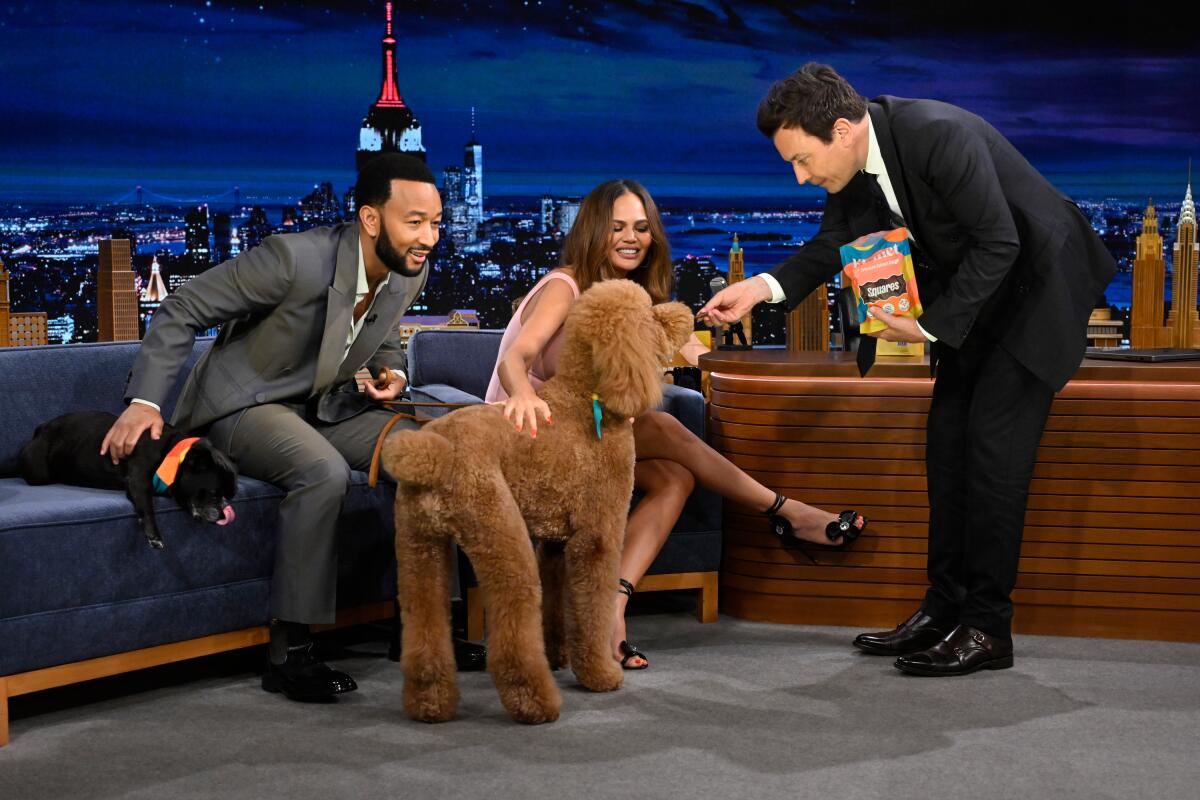
John Legend, left, and Chrissy Teigen, with their dogs Penny and Petey, in a segment with Jimmy Fallon on “The Tonight Show.”
(Todd Owyoung/NBC)
It's recorded in Studio 6B at 30 Rockefeller Center, where both Paar and Carson (before moving to Burbank) did their shows. It's a party and, despite the monologue of the day's news and the occasional guest from the world of Washington, essentially apolitical, certainly compared to Stephen Colbert's “Late Show” and, to a lesser extent, “Jimmy Kimmel Live!” Her goal is to humanize celebrities while preserving their glamour, although the strategy here is less about conversation, which isn't Fallon's strong point anyway, but about engaging them in games and challenges. It's a sleepover for teenagers, with pop stars.
Fallon is now almost 50, but he presents himself as younger: he hasn't aged appreciably on the job, and he relates well to guests half his age. He says “rad” without irony and gets away with it. As a host, he is a big, friendly dog. As an interviewer, he is a percussionist, clapping and banging on his desk with a delight that may seem inauthentic, which he doesn't mean it is. He is an artist, a carpenter, who comes out from behind his desk as often as possible. He sings, he dances. Unlike Leno, Letterman or O'Brien, he doesn't leave the studio much, because why would he? All of his toys (and The Roots, his snappy house band) are there.
So what does the future hold for this franchise? Broadcast television will be no less challenging as new technologies are introduced into home entertainment. It would be foolish to bet that an entity called “The Tonight Show” will still be around 70 years from now, if anyone can watch it, or even a company called NBC, although it would also be foolish to bet that it won't. t. “The Tonight Show” currently ranks third in ratings behind Colbert and Kimmel; but there are all kinds of metrics in modern television, with the Internet and all that. And the chain has organized an anniversary party for him.
“My successor will probably be a robot with artificial intelligence,” Fallon told “CBS Sunday Morning” last year. “A robot talking about… how I laughed too much.” He has another 12 seasons left to match Leno's 22, and another 20 to match Carson's, if that's what he wants, or anyone wants him to do. The only thing that can be said is that, whatever the name and the time, and however that box is filled, it will satisfy the same need at the end of the day, offering some version, as Fallon described it, of “an hour.” . from when you don't have to think and you say, 'Look at this idiot, he's doing something ridiculous,' and then you fall asleep.”
And in his DNA you will find traces of Johnny Carson.

